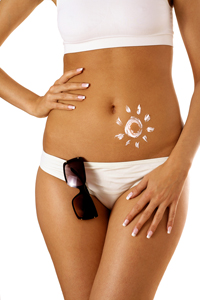There are a lot of myths surrounding sunscreen, tanning, and sun exposure that can lead to neglecting the health of your skin. Harmful UV rays from the sun or tanning beds cause skin damage that can lead to skin cancer. Proper protection and an understanding of how exposure to UV rays effects your body will help you keep your skin healthy.
SUNSCREEN
Many people will wait until they get to the beach to start applying sunscreen. But by the time you put it on you may have already been exposed to harmful UV rays. It’s much better to apply sunscreen at least half an hour before you’ll be in the sun. And when you get to the beach you have to reapply every two hours – no matter how much of a drag you think it is.
Sunscreens should protect from UVA and UVB or have what’s often called “broad-spectrum” protection. Some reports in the media led to a belief that sunscreens may be harmful or cause cancer but current research shows that sunscreens are safe and effective when used as directed.

TANNING
If you think that getting a base tan will protect you from the harmful effects of the sun, you’re wrong. Getting a base tan then sitting in the sun without sunscreen is essentially exposing your self to skin damage twice. There is no such thing as a “safe” tan whether you get it from sun exposure or a tanning salon and any tan is a sign of skin damage. Being born with darker skin may make you less likely to develop skin cancer than someone with fairer skin but the risk is still there. People with darker skin may even be less likely to notice skin cancer when it does arise as easily as those with light skin.
SUN EXPOSURE
If it’s a cloudy day you probably won’t think to put on sunscreen but up to 80% of harmful UV rays get through clouds and fog. This means it’s just as important to protect your skin on a cloudy day. Another common myth is that when it is sunny, exposing your skin will help you produce vitamin D. It only takes about 5 minutes of sun exposure though for maximum vitamin D production to be reached. After that, further sun exposure only risks breaking down vitamin D. Sun exposure can occur through glass like a car window as well. Although UVB rays are blocked, you can still be exposed to UVA rays and you can tan or burn.
With age, the risk of developing skin cancer does increase. This does not mean that because you are chronologically young that you don’t need to protect yourself. Damage from UV rays can be especially harmful during early years and can lead to development of skin cancer later in life. The harmful effects of sun damage may take time to show any symptoms. If the threat of skin cancer doesn’t compel you to wear sunscreen then consider the negative effects on the appearance of your skin such as wrinkles and premature aging.
SKIN CHECKS
Individuals with a low risk for skin cancer should get checked for skin cancer once a year. If you have a family history of skin cancer, if you’re fair skinned, or if you’ve had severe sunburns in your life, you should visit your dermatologist every six months. Early detection of skin cancer is crucial as removal at an early stage is easier and will help prevent potential spreading of the cancer.
GET YOUR SKIN EXAM TODAY!
Schedule your appointment with one of the board-certified dermatologists at Advanced Dermatology, P.C. today. We have 13 conveniently located office locations in New York and New Jersey. Our offices are located in and serve the surrounding areas of: Manhattan, Fresh Meadows, Bayside, Ossining, Briarcliff, Park Slope, Commack, East Setauket, Roslyn Heights, and West Islip in New York as well as Summit and Ridgewood, New Jersey. To contact one of our offices CLICK HERE.
